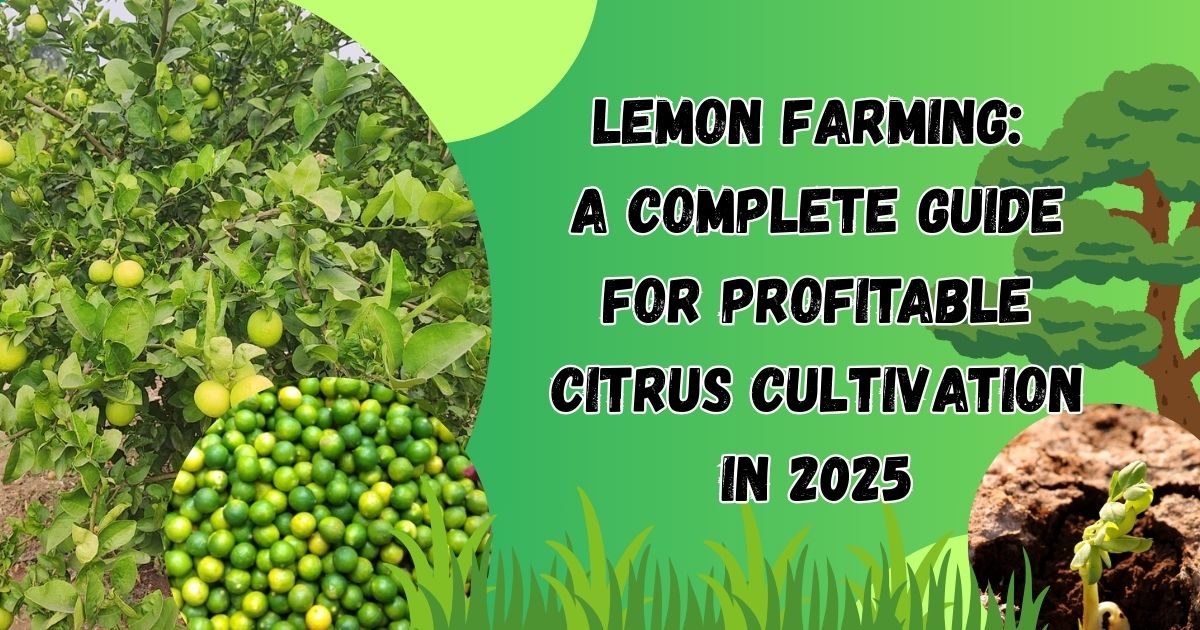Lemon Farming: A Complete Guide for Profitable Citrus Cultivation in 2025
Lemon farming continues to grow in popularity among modern agricultural entrepreneurs, blending ancient practices with new technology for sustainable, high-yield production. If you’re looking to tap into this lucrative market, read on to discover everything you need about lemon farming—from variety selection and soil preparation to pest management and harvesting.

Table of Contents
Why Lemon Farming?
Lemon (Citrus lemon) is cherished worldwide for its refreshing taste, high vitamin C content, and broad applications in culinary, cosmetic, and pharmaceutical industries. With the right approach, lemon farming offers impressive yields and strong profitability, making it a top choice in 2025 for aspiring agribusinesses
Best Lemon Varieties.
Choosing suitable varieties is crucial:
- Eureka
- Lisbon
- Assam Lemon
- Pati Lemon
- Kagzi Kalan
Eureka is especially prized for its high yield and good quality fruits
Click on the button below for plants or seeds.
Ideal Soil and Climate For Lemon Farming
Soil: Well-drained loamy or sandy loam, slightly acidic (pH 5.5–6.5)
Climate: Dry, warm conditions (20–30°C), and protection from waterlogging is essential.
Planting Techniques
Use 3–4-year-old, nursery-raised plants for best results.
Plant spacing: 6–8 meters apart to promote strong growth.
Budding and grafting onto sturdy rootstocks is highly effective.
Fertilization and Irrigation
Use a balanced mix of organic and inorganic fertilizers.
Invest in drip irrigation to boost water efficiency and prevent over-saturation.
Regularly monitor and adjust soil nutrients for optimal growth.
Pest and Disease Management
Common threats: Citrus psylla, aphids, powdery mildew.
Practice Integrated Pest Management (IPM) using neem oil and other organic controls.
Maintain field hygiene and monitor pest populations regularly.
Harvesting and Yield
Lemon trees typically:
- Begin fruiting 3–4 years after planting.
- Yield on average 100–150 kg per mature tree annually.
- Produce fruit year-round, depending on local climate and care.
Harvest fruits when they reach full size and turn bright yellow for best taste and shelf life.
Tips for Boosting Efficiency and Profit
Adopt precision agriculture tools (like drones and soil sensors) for real-time crop monitoring.
Implement advanced irrigation and resource management systems.
Explore direct-to-consumer sales (online delivery, restaurant partnerships, farmer’s markets).
Invest in renewable energy solutions such as solar to cut operational costs by up to 30%.
Final Thoughts
By blending traditional wisdom with new technologies, your lemon farming venture can thrive in today’s competitive agriculture market. Prioritize soil health, water conservation, and direct marketing channels for a truly sustainable and profitable lemon orchard.
FAQs
1. What is the best time to plant lemon trees?
For maximum survival and yield, plant lemon trees in early spring (March–April) in most regions. This timing takes advantage of optimal temperatures for root development and reduces stress from summer heat
2. What soil and pH are best for lemon cultivation?
Lemon trees thrive in well-drained loamy or sandy loam soil with a pH of 5.5–7.5. Proper drainage and sunlight are essential for healthy growth and fruit quality.
3. How much water do lemon trees need?
Newly planted lemon trees require irrigation every 8–10 days during summer and every 25–30 days in winter. Avoid waterlogging, especially in poorly drained soils.
4. How many years until lemon trees bear fruit?
Lemon trees generally start to bear fruit 3 to 4 years after planting. Some varieties may take slightly longer depending on care and local climate.
5. What are the most productive or recommended lemon varieties?
Popular varieties include Eureka, Lisbon, Assam Lemon, Pant Lemon, and Punjab Baramasi. These are chosen for yield, pest resistance, and fruit quality.
6. Which fertilizer is best for lemon trees?
Balanced NPK fertilizers, along with organic manure such as farmyard manure or compost, work best. Nitrogen needs increase as trees mature; phosphorus and potassium requirements are lower but still important for fruit set and disease resistance.
7. How to increase foliage and flowering in lemon trees?
Proper pruning, adequate sunlight, and regular application of balanced fertilizers encourage denser foliage and abundant flowering. Avoid overwatering and control pests promptly.
8. How do I control pests and diseases organically?
- Use neem oil, introduce beneficial insects (like ladybugs), and apply organic mulches.
- Practice good field sanitation and monitor regularly for pests like citrus psylla, aphids, and fungal infections.
9. Can intercropping be done with lemon trees?
Yes, intercropping with crops like vegetables, legumes, or cowpeas in the first 2–3 years helps utilize space and enrich soil fertility without competing for resources.
10. What are common problems for beginner lemon farmers?
- Choosing unsuitable varieties for local climate
- Overwatering or planting in poorly drained soils
- Ignoring pest or disease monitoring
- Planting at the wrong time or with improper pit preparation
